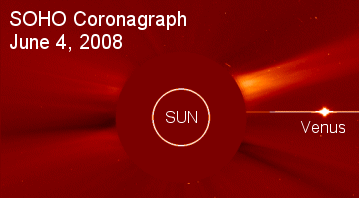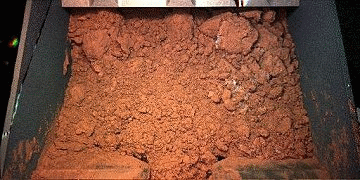| FLYBY ALERT! Space shuttle Discovery launched on May 31st. Get your flyby alerts from Space Weather PHONE | | | ISS IN BROAD DAYLIGHT: Veteran sky watcher David Moore of Dublin, Ireland, has sighted the ISS with the naked eye in broad daylight. "I saw it on June 2nd around 9:21 pm local time while the sun was still 2.1o above the horizon." Impossible? Consider the following: Venus is visible in daylight, and the growing ISS (with Discovery docked alongside) is now brighter than Venus. "It was remarkably easy to see," he says, "even though I was not wearing my spectacles." Of course, the space station is still easier to see in the dark. Check our Satellite Tracker for times to look. FULL VENUS: On June 9th, Venus will pass directly behind the sun--an event astronomers call "superior conjunction." Sun-blocking coronagraphs onboard the Solar and Heliospheric Observatory (SOHO) are monitoring Venus as it disappears into the glare: 
Too bad we can't peek around the sun's limb on June 9th to see Venus on the other side. Like the Moon, Venus has phases and on June 9th the planet will be gloriously full. The entire hemisphere facing Earth will be illuminated. Venus's acid-laced clouds are terrific reflectors and a full Venus would surely be visible during daylight hours, an intense pinprick of light in the blue sky. If only the sun were not in the way.... A SCOOP OF MARS: Phoenix's 7.7-foot robotic arm has reached out and taken its first scoop of Mars. A camera attached to the arm snapped this picture of the harvest on June 2nd: 
Note the bright white material highlighting the red crumbly soil. "We don't know what this material is yet," says University of Arizona's Pat Woida, a senior engineer on the Phoenix team. It could be "ice, a salt or something new." This first scoop was just a test, a light workout for the newly extended arm, and the contents were dumped back onto the ground. Soon, however, similar samples will be drawn inside the lander for analysis by microscopes, electrical and thermal probes, a mass spectrometer and a wet chemistry lab. The mystery material may yet be known. Stay tuned for updates. 3D BONUS: Like a human being, Phoenix's stereo camera has a right and left eye for seeing things in three dimensions. Using images from the two points of view, graphic artist Patrick Vantuyne of Belgium has created some superb anaglyphs of the lander's surroundings. Put on your 3D glasses and behold: Mars Yeti (Phoenix's arm makes a first impression on the Red Planet); One small step... (one of the lander's three feet); Vines (the camera's mast casts a criss-crossed shadow on the ground).
May 2008 Aurora Gallery
[Aurora Alerts] [Night-sky Cameras] | 
